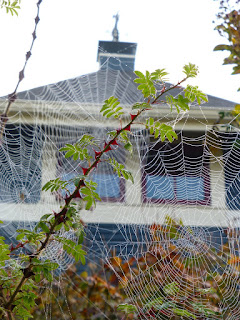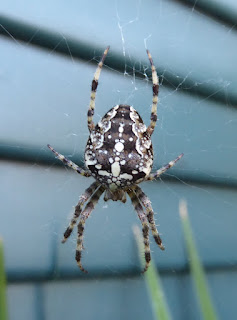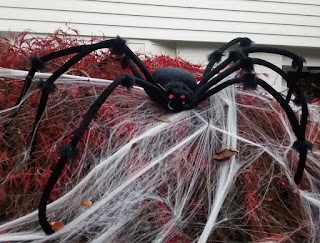 So there I was minding my own business when someone mentioned that orb-weaving spiders made up their webs fresh every day. Like everyone knows that. Like, it’s certainly the kind of thing a person who tries to pay attention would know. Especially if she were an attention-paying person whose father photographed spiders for fun and who has an actual degree in biology. “You mean they suck their whole web back up their butts and start over every day?” I asked, betraying myself.
So there I was minding my own business when someone mentioned that orb-weaving spiders made up their webs fresh every day. Like everyone knows that. Like, it’s certainly the kind of thing a person who tries to pay attention would know. Especially if she were an attention-paying person whose father photographed spiders for fun and who has an actual degree in biology. “You mean they suck their whole web back up their butts and start over every day?” I asked, betraying myself.
“Pretty much,” came the answer. Well!
I had no idea. In retrospect, I think I know where I went wrong. I never wake up early enough to notice what my spiders are doing. Also? I can go weeks without making the bed. I’ve fixed skirt hems with Scotch tape. If I went to the trouble of crocheting something as magnificent as a web out of my own butt, I’d let it go as long as I could. Throw on a patch as needed, and call it a day.
But orb weavers are better citizens than me in that respect. It turns out to be true: spiderwebs have existed for more than a hundred million years, but most last only a day. The spiders do not suck them back up their butts: they eat them, and start fresh, usually in the evening. It’s probably a sensible thing to do, evolutionarily speaking, since they count on their webs for snagging the groceries, but who knows how it got started? Could be some of them just got peckish of an evening, and ate their webs, and then they were all dammit and they had to start over, and those are the ones who were most successful and got their genes passed down. Score one for gluttony.
 Speaking of gene-passing, male spiders are probably the most libidinous creatures on earth. They’d have to be, since they survive courtship only 20% of the time, and if they try for a twofer, they’re done for. The longer the male remains mounted, the deader he’s going to be. He might get away with a five-second job, but if he hangs on ten seconds, the female is going to eat him, and not in a good way. So that extra five seconds must really be something. It’s not too bad for the female either. Her suitor might use a special silk strand that vibrates in such a way as to entice her–that would totally work on me, too–and also he brings dinner. In the form of himself.
Speaking of gene-passing, male spiders are probably the most libidinous creatures on earth. They’d have to be, since they survive courtship only 20% of the time, and if they try for a twofer, they’re done for. The longer the male remains mounted, the deader he’s going to be. He might get away with a five-second job, but if he hangs on ten seconds, the female is going to eat him, and not in a good way. So that extra five seconds must really be something. It’s not too bad for the female either. Her suitor might use a special silk strand that vibrates in such a way as to entice her–that would totally work on me, too–and also he brings dinner. In the form of himself.
Almost all spiders have eight eyes, set up in various ways and pointing in various directions, which is helpful for keeping the kids in line, in those species that watch out for their kids. Most don’t, on account of being dead at the time, like Charlotte. You will recall that Charlotte’s kids all parachuted away from Wilbur the pig, except for three, and that is indeed what happens in many species. First thing an itty bitty baby spider does is stick its butt in the air, and if there’s any breeze at all, it tugs silk out of the spider. I imagine that feels kind of nice. And once the strand of silk is long enough, it takes off on the breeze and carries the spider away, because it is so very tiny and lightweight. It’s a nice start to life.
 But other spiders do tend to the chilluns, like the wolf spider. The wolf spider will carry her egg sac around on her spinneret, holding her rear end up in the air so as not to drag it in the dust, and then when the eggs hatch, a thousand teeny tiny spiders climb up her legs and pile up on her abdomen, and it doesn’t creep her out at all, so don’t you complain.
But other spiders do tend to the chilluns, like the wolf spider. The wolf spider will carry her egg sac around on her spinneret, holding her rear end up in the air so as not to drag it in the dust, and then when the eggs hatch, a thousand teeny tiny spiders climb up her legs and pile up on her abdomen, and it doesn’t creep her out at all, so don’t you complain.
Because I felt remorse over not having known about the daily web construction, I recently observed a spider right outside our window, and discovered all on my own that she achieves such perfection in her web by measuring it out with her own foot. She grabs a previous portion of the web with a foot while dabbing her butt on the radius to attach the strand, so it’s always exactly the same distance away. I discovered this my own self, although, as it turns out, this is not information new to science. I can’t help that.
We used to have orb weavers building webs over nearly every window in our house — which I enjoyed. But for the past few years, there haven't been any. We don't use any toxic chemicals, so I'm wondering if it's the birds that are eating them? I mean, a window is a perfectly visible location, and a bird might see the spider and think "breakfast!" I miss them. They were always a harbinger of the transition from summer to fall for me.
But the birds were there before! Hmm. For me they were a sign I needed to roll the next person's mail bundle up and swing it in front of my face as I approached the mail slot.
Man, I need a warning before those close-up spider pictures. Breakfast almost made a return trip.
I guess my dad was afraid of spiders and made a concerted effort to get over it. He sure wasn't afraid by the time I came along. (Of course, having children probably eclipses all other fears.)
There were times in earlier courtship that I thought, "If she will just let me do this once, I could die happy." I think I must be descended from spiders.
I'm not sure how many eyes my step-mom had, but I know she had some in the back of her head.
"Okay, I'm ready to die, but just let me finish first…"
I'm OK with spiders, especially those really cute ones I saw on TV last week that were made out of chocolate truffles, with pretzel pieces for legs and bright red eyes glued on with melted chocolate chips. https://www.pinterest.com/pin/224546731398589874/
All ready to appreciate, and then: NOOO! Those truffle spiders have SIX LEGS!!
Our orbs seem to have gone. They were everywhere last week??
I never notice WHEN things go missing. I notice they've been missing for a while.
Such a pretty spider! (The real one, not that plastic monstrosity.) Next year, maybe you'll want to join us in Arachtober. (Flickr group, where we all post a spider a day for the entire month. Fun!)
My kind of way to waste time, yes.
Well you'd certainly see some beauties from around the world
you've awakened a memory here; soon after I moved in here, I pulled aside my shower curtain and surprised a fuzzy looking spider, which I then smacked at with my thong (flip-flop) and a gazillion tiny babies detached themselves and ran in all directions! I'd never seen such a thing before. I squirted that room so full of insecticide I have to put off my shower until the next day. These days I just move any spiders back outside where they belong.
There are certain spiders that give me a start. The thick-legged dark ones and the ones that run like the wind. I've been known to relocate indoor spiders, but unfortunately, I think the indoor ones ARE meant to be indoors, and don't make it outside. Perhaps someone will correct me?
We leave the indoor spiders alone. In fact, on cleaning day, we tell each other where we've seen spiders, and we clean around them. I think that they keep our house free of more noxious bugs. We have a deal with them: They stay off the floor, and we stay off the walls and ceiling. Thus far, it has worked.
Tater has been known to travel around the periphery of one room on the crown molding and she comes back down thoroughly cobwebbed.
I move spiders too. I hope they do survive outside because my spider-fearing partner would make sure that their odds were considerably less than 20 per cent inside.
I'll state right now that I am favorably disposed toward anyone who unhooks a spiderweb in order to pass through and attempts to reattach it afterwards, even though it NEVER works. (Little dating tip, there.)
If my creaky knee allows, I'll crawl under the web at the gate.If the knee objects, I walk down the drive and up the street.
Mimi's approach to live and let live prevails here, too. They eat insects, people. I have watched spiders consume their own web, never occurred to me that they do it daily.
The first picture is a great webshot!
They eat PEOPLE? Oh wait, I see.
Yes, that is one of my favorite photos of all time (that I took).
Maybe. I have an acquaintance in Guatemala who was bitten by a spider this week. Things are not looking good for him. The man,I mean– no idea what happened to the spider.
"then they were all dammit and they had to start over". This struck me as so damn funny. Must remember it for the MANY times I need it. In fact, I think I'll frame it and hang it in my studio.
It's easy to amuse yourself writing dialogue for prehistoric spiders.
The spider in the video reminds me of a classical harpist. Although I suppose to the spider, those strands are a big thicker.
I put spiders outside, too, but that always leaves me feeling bad in the fall because they can't live outside when it gets cold. What to do?
Get an indoor hummingbird?
With two cats?! It's bad enough trying to keep the cats away from the spiders!
If you've a mind to wander over, my Facebook site has some photos https://www.facebook.com/dinahmow1
Nothing like reminding me of Charlotte a female able to inspire imagination via personification.
You too are inspiring. The globe is full of spiders and we rarely get posts. Loved this one.
Indoor one eat indoor critteres even dust mites.
I have a whole collection of those on my pillow, although I try to drown them with drool. Maybe that's why I've seen spiders walking toward me in bed. Mind you, I'm very nearsighted. They're REAL close by the time I recognize them.
The blog are the best that is extremely useful to keep.
I can share the ideas of the future as this is really what I was looking for.
I am very comfortable and pleased to come here. Thank you very much!
ผลบอล